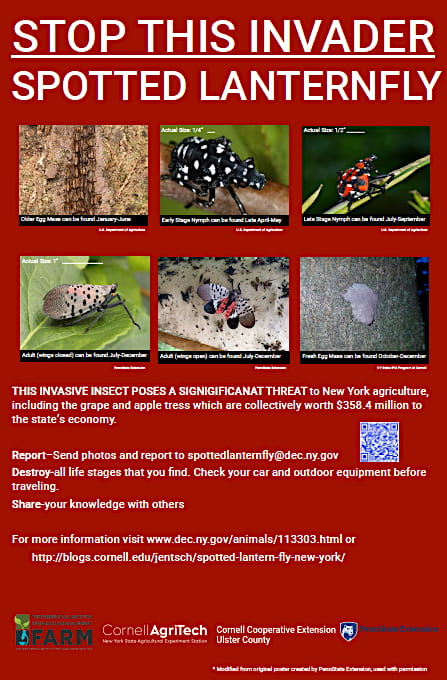
New York State Department of Agriculture and Markets announced on November 12th, 2020 that the Spotted Lanternfly (SLF) adult and overwintering egg masses have been found and are considered to be established populations on Staten Island, areas in the Hudson Valley, and in the Southern Tier.
Specific sites where established and isolated populations exist include Port Jervis, Sloatsburg (87N Rest Stop), Orangeburg, and Ithaca. Last week, students from Cornell University (Ann Hayek’s lab) found live and dead adults and several egg masses in the Ithaca area near housing units. The removal of tree-of-heaven, a preferred host of SLF adults), and targeted systemic and contact insecticide use has been applied in a systemic approach to contain the spread of the invasive pest.

At this point in time, the greatest concern in these regions is for grape production with newly emerging SLF adults in later-July through August very attracted to grape vines just prior to harvest. Increased risk of SLF infestation of vineyards in eastern Long Island, the mid-Hudson Valley and Finger Lakes Region could occur as early as 2021 unless these early established populations can be eradicated come spring.
SLF feedings can stress grape plants, making them vulnerable to disease and attacks from other insects. SLF also excretes large amounts of sticky “honeydew,” which attracts sooty molds that interfere with plant photosynthesis, negatively affecting the growth and fruit yield of plants. The prolonged and repeated feeding of SLF on grape vines is believed to cause significant stress and loos of carbohydrates needed to successfully overwinter, causing decline and death of the vine.
Due diligence by the general public and fellow agriculturalists in scouting for SLF can provide much needed surveillance on the ground for early detection leading to eradication.
New Yorkers can report potential sightings using the web reporting tool found here: Survey123 Form. Capturing a clear image of the SLF life stage, submitting the image to NYS DEC to alert the DEC and NYS Ag. & Markets will bring experts into the area for confirmation and remediation focused on eradication of the developing invasive population.
Identifying SLF (Stop SLF Resources)
* Adult SLF are active from July to December. They are approximately one-inch long and half an inch wide at rest, with eye-catching wings. Adults begin laying eggs in September. Signs of an SLF infestation may include:
* Sap oozing or weeping from open wounds on tree trunks, which appear wet and give off fermented odors.
* One-inch-long egg masses that are brownish-gray, waxy and mud-like when new. Old egg masses are brown and scaly.
* Massive honeydew build-up under plants, sometimes with black sooty mold developing.
The SLF is a transient hitch-hiker, relatively strong flyer and even the nymphs have the capacity to move many meters daily through their climbing and drifting behavior.
For more information on Spotted Lanternfly, visit https://agriculture.ny.gov/spottedlanternfly.



